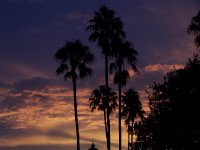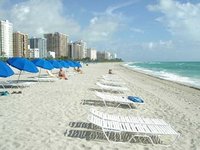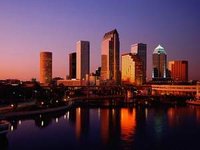Florida
Travel Guide North America USA Southern United States Florida
Introduction
Florida enjoys a subtropical climate and kilometres of coastline, and easily attracts 60 million visitors each year. Amusement parks, natural attractions and modern cities make this one of the USA's premier holiday destinations and it is a popular playground for the 'snowbirds', people from the more northern states of the USA and also from Canada and Europe who will flock here from December to April, the best time for a visit.
Geography
Florida is the most southeasterly state in the USA, bounded by the Atlantic Ocean on the east, the Straits of Florida on the south and the Gulf of Mexico on the west. Spanning two time zones, it extends to the northwest into a panhandle, extending along the northern Gulf of Mexico. It is bordered on the north by the states of Alabama and Georgia, and on the west, at the end of the panhandle, by Alabama. It is near several Caribbean countries, particularly the Bahamas and Cuba. At 105 metres above mean sea level, Britton Hill is the highest point in Florida and the lowest highpoint of any state in the country. Much of the state south of Orlando is low-lying and fairly level; however, some places, such as Clearwater, feature vistas that rise 15-30 metres above the water. Much of Central and North Florida, typically 40 kilometres or more away from the coastline, features rolling hills with elevations ranging from 30 to 75 metres. The highest point in peninsular Florida (east and south of the Suwanee River), Sugarloaf Mountain, is a 95-metre-high peak in Lake County.
Regions
Florida is generally divided into four main geographical areas:
Florida Panhandle
The Florida Panhandle is an informal, unofficial term for the northwestern part of Florida. The term is also generally synonymous with West Florida and Northwest Florida. Cities in this region include Tallahassee, Destin, Pensacola, and Panama City Beach.
North Florida
North Florida includes the region in the northern part of the state, excluding the Florida Panhandle. It includes the vibrant, cosmopolitan city of Jacksonville.
Central Florida
Central Florida is home to some of the world's famous theme parks: Walt Disney World, SeaWorld, Universal Studios Florida. The Kennedy Space Center, Cypress Gardens, Daytona International Speedway and Gatorland are also located in this region.
South Florida
South Florida is home to the populous Miami metropolitan area, the Florida Keys, and other localities. It is the only part of the continental United States with a tropical climate.
Cities
Miami
Divided into two parts, Mainland and South Beach, Miami is one of the most visited destinations in the USA. The busiest part of the city is the Art-Deco district, in South Beach, fully loaded with night-clubs and restaurants; the beach opposite this area is also very popular amongst tourists. In the Key Biscayne area, tourists are offered the chance to visit some celebrities' houses. Shopping lovers would find in Miami a wide variety of shopping malls, such as Bayside, Coco Walk, the Dolphin mall, amongst others. In the end, Miami is the place to be!
Orlando
Located in Central Florida, Orlando is the busiest metropolitan area in the state. The reason for this is undoubtedly the theme parks, and in particular, Walt Disney. With more than a dozen of different parks, Orlando is the place to have fun in family. If you are not keen on family holidays, them parks and other joy, it is best to get out of here as quickly as possible, because Florida has much more enjoyable cities, beaches, nature and culture for you.
Other cities
- Jacksonville is the state's largest city in size and population
- Tallahassee - the capital in the central north
- St. Petersburg - eastern coast of Florida
- Fort Lauderdale - just north of Miami
- Cape Coral
- Crystal River - Manatee capital along the west coast
- Tampa - gateway to the central eastern coast
- Fort Myers - southwestern Florida
- Naples - south of Fort Myers
- Pembroke Pines
- St. Augustine - oldest settlement in the US, along the northeastern coastline
- Key West - the end of the road
- Pensacola - extreme northwestern Pandhandle city
Other significant cities in the state include Hollywood, Delray Beach, Port St. Lucie, Coral Springs, West Palm Beach, Gainesville, Miramar, Clearwater and Pompano Beach.
Sights and Activities
Biscayne National Park
Biscayne National Park is a U.S. National Park located in southern Florida, south of Miami. The park preserves Biscayne Bay and its offshore barrier reefs. Ninety-five percent of the park is water, and the shore of the bay is the location of an extensive mangrove forest. The park covers 70,00ha and includes Elliott Key, the park's largest island and first of the true Florida Keys, formed from fossilized coral reef. The islands farther north in the park are transitional islands of coral and sand. The offshore portion of the park includes the northernmost region of the Florida Reef, one of the largest coral reefs in the world.
Coasts/Beaches
With exciting cities to visit, such as Sarasota, Tampa and Clearwater, and the world-wide famous Everglades National Park, The Gulf Coast is a hidden treasure in Florida. On the other side of the peninsula, the Gold Coast extends itself over sixty miles long on the Atlantic Coast. Daytona Beach, Fort Lauderdale, Palm Beach, Boca Raton and many other cities offer an endless variety of entertainment, culture, nightlife and restaurants. The ride in a car is a must over the A1A. Florida is a state with dozens of amazing beaches – beaches with powdery paper-white sands and crystal clear waters can be found on every coast of the state. Must visit beaches include Cocoa Beach, Vero Beach, Palm Beach, Miami Beach, Panama City Beach, Grayton Beach and Pensacola beach. These beaches are rather popular and crowded, but you cannot go wrong with them. There are smaller and lesser known places you can go to in case you prefer silence over endless beach noise made by tourists.
Dry Tortugas National Park
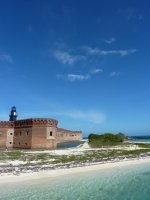
Fort Jefferson, Dry Tortugas National Park
© Utrecht
Dry Tortugas National Park is a national park about 110 kilometres west of Key West in the Gulf of Mexico. The park preserves Fort Jefferson and the seven Dry Tortugas islands, the westernmost and most isolated of the Florida Keys. The archipelago's coral reefs are the least disturbed of the Florida Keys reefs. Fort Jefferson and birdwatching are the highlights here, although there is good snorkelling as well. Visiting the park by private boat is difficult because of its distance, so most visitors come by boat or seaplane from Key West, Florida. Official ferry and transportation services to the Dry Tortugas includes the Yankee Freedom III catamaran and seaplane services. They offer daytrips for US$165 ($120 children), including breakfast, lunch, a tour of Fort Jefferson, snorkelling gear and a great boat trip (usually good weather). Key West Seaplan Charters offers half day and daytrips at (much) higher prices. You can camp at the island for $3 a night but you have to reserve space beforehand, also making sure you book the boatride back.
Everglades National Park
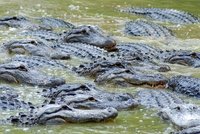
Everglades Gatorade
© zmey
The Everglades encompasses an area of marshland taking up most of the south of Florida. It is a popular tourist destination and the park plays a unique part in local folklore, with legends of moon shiners, smugglers and alligators. The Everglades National Park takes up much of the region. It protects the southern 20% of the original Everglades. In the United States, it is the largest subtropical wilderness, the largest wilderness of any kind east of the Mississippi River, and is visited on average by one million people each year. It is the third-largest national park in the lower 48 states after Death Valley and Yellowstone. It has been declared an International Biosphere Reserve, a World Heritage Site, and a Wetland of International Importance, one of only three locations in the world to appear on all three lists. There are many things to do, including a tram tour at Shark Valley, boat trips from the Gulf Coast Visitor Center (10,000 islands reserve) and Flamingo and beautiful hikes, including the Anhinga Trail.
Florida Keys
The Florida Keys are the most southern point of North America, bordering almost with Cuba. Not only they are quite famous for the beaches and wildlife parks, but also for the nature reserves and architecture. The night life is also another good reason to go to the 'keys'. Key West is the most popular island and therefore the most visited one of the string. From Miami, it takes a good five hours by car to get there, crossing by dozens of bridges.
Manatees
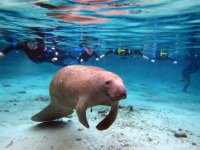
Big Beautiful Manatee
© Utrecht
Florida is one of the best places in the world to see manatees without too much effort. There are dozens of places along the coast (mainly the southern half of the state) where you will see this big beautiful creatures of nature. Several of them are difficult to get to or are forbidden to enter by travellers. Others can only be reached independently for example by kayaking or walking a bit to a place you can spot them. But the Manatee Capital of the world is Crystal River, about midway along the west coast. The main season is winter, from December till April, with peaks in January and February when the weather is at its coldest. Especially after brief cold spells when temperatures can drop to around zero, the manatees will flock here in the hundreds at least. But even on a normal day there are at least a dozen or so of these fantastic animals that you can spot. There are loads of tour operators in the area, so it's best to check Tripadvisor's Activities in Crystal River to decide which one is perfect for you. There won't be any major differences, but one tip is to go as early as possible. Some of them leave just after 6:00am which is recommended.
Seven Mile Bridge
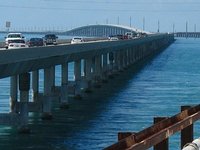
Seven Mile Bridge
© porz
The Seven Mile Bridge is a famous bridge in Monroe County, Florida Keys, United States. It connects Knight's Key in the Middle Keys to Little Duck Key in the Lower Keys. Among the longest bridges in existence when it was built, it is one of the many bridges on US 1 in the Keys, where the road is called the Overseas Highway. There are two bridges in this location. The older bridge, originally known as the Knights Key-Pigeon Key-Moser Channel-Pacet Channel Bridge, was constructed from 1909-1912 under the direction of Henry Flagler as part of the Overseas Railroad. The current road bridge was constructed from 1978 to 1982. The vast majority of the original bridge still exists, used as fishing piers and access to Pigeon Key, but the swing span over the Moser Channel of the Intracoastal Waterway has been removed.
The total length of the new bridge is actually 6.79 miles, and is shorter than the original. Each April the bridge is closed for approximately 2.5 hours on a Saturday and a "fun run," known as the Seven Mile Bridge Run.
Other Sights and Activities
Events and Festivals
Holidays
- New Year’s Eve - The US celebrates the outgoing of the old year and incoming of the New Year quite dramatically. Every state boasts its own parties to ring in the New Year, but none is more extravagant than New York’s Time Square, which sees people overflowing into the neighboring restaurants, bars, parks, beaches, and neighborhoods.
- Martin Luther King Jr. Day (officially Birthday of Martin Luther King, Jr. and sometimes referred to as MLK Day) is an American federal holiday marking the birthday of Martin Luther King Jr. It is observed on the third Monday of January each year, which is around King's birthday, January 15. The holiday is similar to holidays set under the Uniform Monday Holiday Act. The earliest Monday for this holiday is January 15 and the latest is January 21. King was the chief spokesperson for nonviolent activism in the Civil Rights Movement, which successfully protested racial discrimination in federal and state law.
- St Patrick’s Day - March 17 celebrates the US’s large Irish population. Many cities around the country boast boisterous parades and Irish-themed parties, especially New York and Chicago, where the river is dyed green. Be wary of the drunkenness that dominates as this is definitely a party-day.
- Memorial Day - Memorial Day is an important holiday throughout the United States, but not for crazy festivities. Parades commemorating wartime heroes are often held and the day is also the ‘unofficial’ start of summer. Most visitors follow the crowds to parks and beaches, which are capped off with informal BBQs.
- Independence Day - Also known as the Fourth of July, Independence Day celebrates the US’s break from the British during the 18th century. Barbecues, street parties, beach trips, and weekend getaways are commonplace to appreciate freedom.
- Labor Day is a public holiday celebrated on the first Monday in September. It honors the American labor movement and the contributions that workers have made to the strength, prosperity, laws, and well-being of the country. It is the Monday of the long weekend known as Labor Day Weekend. It is recognized as a federal holiday. Beginning in the late 19th century, as the trade union and labor movements grew, trade unionists proposed that a day be set aside to celebrate labor.
- Halloween - Halloween is a fun holiday on October 31 for all generations to dress up in costumes and relive their youth. Children walk around the neighborhood trick-or-treating for candy, while adults attend parties. Other seasonal events include haunted houses, pumpkin farms and carving, and corn mazes.
- Thanksgiving - On the fourth Thursday in November, Thanksgiving is held in almost every home in the US. Tourists will have a hard time finding anything to do as the country essentially shuts down in observation. A typical Thanksgiving meal consists of turkey, stuffing, mashed potatoes and pumpkin pie commemorating the original Pilgrim’s feast at Plymouth Rock.
- Christmas - On December 25, Christians celebrate Christmas as the pinnacle of their calendar by attending church and opening gifts from Santa Claus. Almost everything shuts down to promote family togetherness. The northern regions hope to experience a “white Christmas,” with trees and festive lights blanketed by snow.
Sport
- Super Bowl Sunday - the world’s most watched sporting event and one of the highest grossing TV days of the year, Superbowl Sunday is a spectacular extravaganza. Held the first Sunday in February, the Superbowl is the final playoff game between the NFL’s top two teams. The venue rotates every year around America, yet the local parties seem to remain. Pubs, bars and restaurants are great places to enjoy the Superbowl or locals throw their own parties with different variations of betting.
- The World Series is the annual championship series of Major League Baseball (MLB) in North America, contested since 1903 between the American League (AL) champion team and the National League (NL) champion team. The winner of the World Series championship is determined through a best-of-seven playoff, and the winning team is awarded the Commissioner's Trophy. As the series is played during the fall season in North America, it is sometimes referred to as the Fall Classic.
- The Daytona 500 is the start of the NASCAR Sprint Cup and the most prestigious one of them all. It is held on a Sunday during the second half of February and attracts over 150,000 visitors every year. Tickets vary from just about US$50 to hundreds of dollars for VIP tickets, usually sold in combination with tickets for other events or as a package for the whole weekend.
Weather
Florida is the warmest state of mainland USA. Only Hawaii has comparable weather. Temperatures are usually between 25 °C and 30 °C for most of the year, a bit warmer from June to September and cooler from November to March. The north is rather colder though during winter, when winds from the north occasionally bring frost and possible snowfall, but this is rather rare. Conditions are hot and sticky for most of the year in the southern area. June to November is the rainy season and hurricanes are a possibility for most of the state during this time. Florida leads the United States in tornadoes per area (when including waterspouts) but they do not typically reach the intensity of those in the Midwest and Great Plains. Hail often accompanies the most severe thunderstorms.
Getting There
By Plane
1. Miami International Airport (MIA/KMIA) is the city's main airport and is one of the United States' largest airports. It is located around 13 kilometres from downtown Miami. There are non-stop routes from and to well over 100 destinations worldwide, including cities throughout North and South America, Europe and the Middle East. Miami International Airport is also the largest international gateway for American Airlines, which has nearly 100 destinations served alone!
Some of the main destinations are Buenos Aires, Mexico City, Havana, Düsseldorf, Toronto, Madrid, Paris, New York, Los Angeles, Chicago, Aruba, La Paz, Lima, London, Rio de Janeiro, St. Thomas, Panama City, Manaus, Santiago, Frankfurt, Sao Paulo and Washington, D.C..
To/from the airport
- Bus: Miami-Dade Transit provides excess with its Metrobus.
- Rental cars, shuttles and taxis are available at the airport
- Rail: There are free shuttle buses to nearby Tri-Rail stations.
2. Orlando International Airport (MCO) is the major airport for the city and many airlines serve destinations within the USA and to Europe and South America. The airport is located about 11 kilometres from the CBD of Orlando. It's the second busiest airport in Florida and even in the top 30 worldwide.
To/from the airport
- Bus: Lynx provides a sub-station at the airport with service to Downtown Orlando and other area routes.
- A complimentary coach transportation service for guests staying at Walt Disney World resort hotels. The motor coach service is operated by Mears Transportation. Guests have to book in advance reservations.
- Royal Caribbean International, Carnival Cruise Lines, Disney Cruise Line, SunCruz Casinos, Sterling Casinos and Mears Transportation all run scheduled buses from the airport to Port Canaveral for incoming cruise passengers
- The community of The Villages in Sumter, Lake, and Marion counties operates a shuttle between the community and Orlando International Airport. The shuttle stops at Lake Sumter Landing and Spanish Springs
- Taxis and rental cars are both widely available at the airport as well.
3. Fort Lauderdale-Hollywood International Airport (FLL) has a number of international connections as well as a fair number of domestic flights. It is located about 5 kilometres from the CBD of Fort Lauderdale and about 33 kilometres from Miami.
To/from the airport
- Bus: The airport is served by Broward County Transit bus Route 1. It has connecting service through the Central Terminal, and also buses to Aventura, in Miami-Dade County.
- Rail: Rail service is provided by Tri-Rail, at the Fort Lauderdale/Hollywood International Airport Tri-Rail station, where there is a shuttle that goes to the airport.
- Car: The airport offers airport parking and has rental car facilities. Taxis are available as well.
4. Southwest Florida International Airport (RSW), also known as Fort Myers International Airport, is the main gateway for Fort Myers and the surrounding area, including Cape Coral and Naples. It mainly has connections to other cities in the USA, but there are quite a few flights to Toronto and less so to Montreal and even Düsseldorf.
5. Tampa International Airport (IATA: TPA, ICAO: KTPA, FAA LID: TPA) is located around 11 kilometres from Tampa's CBD. A few dozen of airlines serve the airport, mainly on domestic routes, but there are a few interesting alternatives on international routes, like the one to London Gatwick Airport.
Other airports with mainly domestic flights are located near Palm Beach, Melbourne, Daytona, Jacksonville, Tallahassee and Pensacola.
By Train
- The Autotrain travels between Lorton, Virginia and Sanford, Florida.
- The Silver Service/Palmetto travels between New York and Tampa and Miami, stopping in Washington, D.C., Charleston and Jacksonville, among many other places.
By Car
Three Interstate highways connect Florida with adjacent states:
- Interstate 95 enters Florida from Georgia just north of Jacksonville and parallels the Atlantic coast (never more than 25 miles) until its southern terminus south of the Miami CBD. Interstate 95 provides the most convenient route for persons from the Atlantic Coast, New England, and the Canadian maritime provinces. Jacksonville, Daytona Beach, and the Miami-Ft.Lauderdale-West Palm Beach area are all serviced by I-95, with access to Orlando provided via I-4
- Interstate 75 also enters Florida from Georgia and passes through the center of the state until the Tampa Bay area, after which it follows 10-20mi inland from the Gulf of Mexico until Naples, after which it heads due east to Ft.Lauderdale. Interstate 75 is most convenient for travelers arriving from Atlanta and the Midwest.
- Interstate 10 enters Florida from Alabama near Pensacola and passes through the center of the Panhandle and through northern Florida until its terminus in Jacksonville. Interstate 10 is most convenient for travelers from Louisiana, Texas, and areas further west.
Additional major highways entering Florida include:
- US 1 enters Florida north of Jacksonville and snakes along the east coast between Interstate 95 and the Intercoastal Waterway/Atlantic Ocean. Unlike I-95, US 1 continues past Miami and is routed over a series of bridges connecting the Florida Keys to its terminus at Key West.
- US 231 enters Florida from Alabama (where it connects with Interstate 65 in Montgomery) and crosses the Panhandle north-south to its southern terminus at Panama City. US 231 provides convenient access to the Panhandle from the Midwest (via I-65).
- US 98 enters Florida near Pensacola and remains close to the Gulf of Mexico coast until the base of the Florida peninsula("Big Bend" area). Unlike I-10 to the north, which runs through the interior of the peninsula and away from the coast, US 98 provides convenient access to the coast and this section is very scenic. After the Panhandle, US 98 runs diagonally across the peninsula to West Palm Beach, running through primarily rural areas.
- US 27 enters Florida from western Georgia, provides access to the state capital, Tallahassee, before routing through mostly rural areas of the peninsula. Between the Florida Turnpike and Miami, US 27 is a primary trucking route through the center of the state and, while two or three lane and having high speed limits, this route can be a hassle dealing with trucks and large volumes of traffic through this section.
- US 301 enters Florida just north of Jacksonville and was once the main route from the Northeast to Florida. It is a very scenic alternative to I-95 with a lot less traffic. Exiting at Santee, SC motorists can follow US 301 through SC and Georgia (past the first welcome center opened in 1962) and connect to I-95 in Jacksonville for East Coast destinations or join I-75 at Ocala for Tampa and Gulf Coast destinations.
By Bus
Check Greyhound for options. Amtrak has some coaches in additions to trains.
By Boat
Discovery Cruise Line operates a daily (except Wednesdays) cruise ferry between Port Everglades, Fort Lauderdale in Florida and Freeport on Grand Bahama. It leaves at 9:30am from Fort Lauderdale, arriving in Freeport around 1:30pm, and returns from Freeport at 5:15pm, arriving in Fort Lauderdale around 10:30pm. So a one-way trip takes around 4 hours to the Bahamas, and about 5 hours back, which barely leaves you 4 hours at Grand Bahama Island. There are options to spend the night though and take a ferry the next day back to Florida. Services on board include three buffet meals and a Las Vegas style casino! A return ticket costs around US$140.
Getting Around
By Plane
There are some intrastate flights in Florida, connecting Miami with Jacksonville, Tallahassee and Pensacola for example. Within Southern Florida, it hardly pays off to fly as distances are relatively short.
By Train
Tri Rail offers connections between Miami and Palm Beach. All other connections are with Amtrak.
By Car
You will find most of the big cities with rental offices by one or more of these companies so picking up a rental car in Florida is easy. Prices will vary depending on the time of the year you are booking. Many international rental companies have a wide selection of rental cars and these include SixtHertz, Avis, Dollar, Thrifty, Enterprise, Budget and Alamo/National. Most companies will require you are at least 25 years of age, although younger people might be able to rent cars at slightly higher rates and with some insurance differences as well. A national driver's license is usually enough, but an additional international one is recommended. Also note that it usually costs more to include lots of other extra things. For example extra drivers, GPS, the first full tank, SLI (Supplemental Liability Insurance), PAI (Personal Accident Insurance, usually covered already at home), road assistance/service plan, and drop-off costs for one-way rentals.
If you want to book a car, it is recommended that you book your car before arriving in the USA. This is almost always (much) cheaper compared to just showing up. Also, try and book with a so-called 'broker', which usually works together with a few or many car rental companies and can offer the best deal. Some examples include Holidayautos, Holidaycars and Sunny Cars. Some of the cheapest deals to book from Europe, includes Drive-USA, which also has a German version.
For more information and tips about renting cars and campers, additional costs, insurance, traffic rules, scenic routes and getting maps and fuel it is advised to check the USA Getting Around section.
Florida has a number of National Scenic Byways which offer a great way to explore the state crossing beautiful landscapes. Mostly, there are lots of national parks, state parks or monuments along the way and it's generally a better alternative than the faster but boring Interstate Highways.
By Bus
Bus service is provided by Greyhound and RedCoach that connect the major cities in Florida. There are a number of local and regional Public Transportation organizations that offer inter-city bus services throughout the state.
By Boat
A high speed ferry service operates from the cities of Fort Myers Beach and Marco Island to Key West. The Key West Express offers daily service and docks in the Historic Seaport district of Key West. The ferry ride takes approximately 3.5 hours and the Ft. Myers Beach vessels have a capacity exceeding 300 passengers and amenities aboard include; out-door sundecks, flat-screen TV's, galley service and a full bar.
Eat
Florida's cuisine has come under many influences and its styles vary across the state from north to south. Early Spanish and African and Southern cuisine has been influenced by Cuban and other Caribbean cultures, as well as "snowbirds" escaping from the Northern US winters. Northern Florida has a more Southern style; the south a more Caribbean one. Being on a peninsula, Florida's chefs have always had access to fresh seafood and the long growing season provides for fresh native vegetables.
Drink
Alcoholic beverages abound throughout the state. However, five rural counties in the northern third of the state are "dry counties", and no alcohol is sold in them. Liquor stores are often built into strip malls, supermarkets, and pharmacies, and most grocery stores, gas stations, and convenience stores sell beer and wine. Bars and clubs are popular throughout the state. Miami Beach is well known for a variety of themed and upscale bars with innovative mixed drinks.
No visit to Florida is complete without a cup of their famous orange juice. In most of the welcome centers, you can have a sample.
Like every other U.S. state, the purchase and possession age for alcohol is 21 and is fairly well enforced. Underage drinking "stings" are frequent in most tourist areas.
Sleep
Hotel and Motel Chains
There are dozens of hotel and motel chains, ranging from budget to top end. Allthough they are not the most charming accommodations, they usually have a very decent midrange service with good rooms and are generally good value. At least you know what to expect and in some cases they are either the only or the best option in the area. Some of them include:
- Motel 6
- Super 8
- Days Inn
- Quality Inn
- Red Roof Inn
- Howard Johnson
- Best Western
- La Quinta Inns and Suites
- Holiday Inn
- Econo Lodge
- Travelodge
- Hilton
- Choice Hotels
- Ramada
- Radisson
- Starwood Hotels
- Marriott Hotels
Deluxe Accommodations
Florida boasts many exclusive and even over-the-top hotels and condominiums for vacation rental, overlooking the great beaches on the Atlantic Ocean and the Gulf of Mexico, near high-fashion spots like South Beach, Amelia Island and Boca Raton, or more low-key areas like Pensacola Beach, at the far western end of the Florida Panhandle, close to Mobile, Alabama. Here are two adjacent to the Gulf Shores National Seashore and the quaint village of Pensacola Beach.
References
- 1 2010 census - FL. U.S. Census Bureau. Retrieved on 2013-01-11.
Contributors
 Utrecht (82%)
Utrecht (82%)
from https://utrecht.travellerspoint.com
as well as Hien (6%), OceanFl (3%), Peter (3%), zarmaxia (2%), NuMexiKan (1%), santafestyle (1%), JoyLee112 (1%), dr.pepper (1%), nigelpeaco (<1%)
Florida Travel Helpers

greatgrandmaR
Ask greatgrandmaR a question about FloridaLived in various places in Florida for several years and spent a lot of time there

Wander Florida
Ask Wander Florida a question about FloridaI have lived in different parts of Florida for over 20 years.

espressivist
Ask espressivist a question about FloridaI am familiar with Pensacola Beach and Gulf Breeze, FL.

gr8bertino
Ask gr8bertino a question about FloridaI am (nearly) a Native Floridian who has lived in the state for 3/4 of my life. I am a South Florida local (Miami-Ft Lauderdale), but have traveled everywhere east of Tallahassee.
This is version 87. Last edited at 9:07 on Jun 12, 19 by Utrecht. 63 articles link to this page.

Except where otherwise noted, content of this article is licensed under a Creative Commons Attribution-ShareAlike 3.0 License

